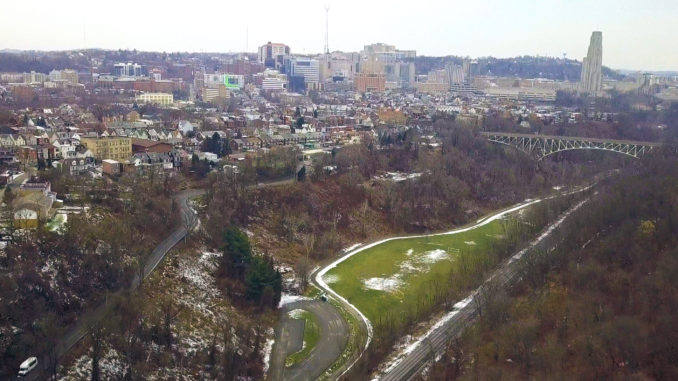
By Chris Zurawsky
Pittsburgh’s Schenley Park was once a horseback riding haven. While the stables and a racetrack are long gone, the Bridle Trail remains—a reminder of a bucolic past and a refuge from the surrounding city.
At its eastern end, the 1.4-mile walking and biking path starts at a busy five-way road intersection but quickly dips into dense woodland, clinging to a rocky hillside above an interstate highway. Built in the 1950s, the high-traffic commuter route skirts the park in a stream valley—Four Mile Run—where a neighborhood of approximately 172 households and a handful of businesses hangs on amid the roar of tractor trailers, overpass infrastructure, and persistent flooding caused as much by municipal neglect as geographic location.
When the trees are bare, the Bridle Trail affords a birds-eye view of “The Run”—including the twin onion domes of St. John Chrysostom Byzantine Catholic Church, Andy Warhol’s childhood place of worship. Unfortunately, the noise and visual pollution of the interstate mars the natural and man-made beauty.
About halfway along its route The Bridle Trail takes a sharp turn north above another, smaller streambed, Junction Hollow. As the trail crosses multiple stone bridges, built by the federal Works Progress Administration at the end of The Great Depression, one is struck by the quiet: a sharp shift from the drone of speeding vehicles to bird songs, creaking tree branches, and the rustle of leaves.
Formerly a residential and industrial corridor serving steel mills on the Monongahela River, today Junction Hollow is home to a soccer field and a popular bike trail connecting the city’s universities to the riverfront. While a train line still runs through, the occasional blast of a locomotive’s whistle and the clank of steel wheels on rails are as much a romantic reminder of simpler times as modern-day intrusions.
After purchasing 28 acres of Junction Hollow from a private parking lot owner in 2000, the city solidified its status as a natural area in 2005 with a resolution declaring that the parcel “shall hereafter officially be dedicated for park purposes and shall be added to the boundary of Schenley Park.”
Twenty years on, however, the explosive growth of Pittsburgh’s “eds and meds”—higher education and health care—is posing a serious threat to Schenley Park, especially a proposed shuttle bus road primarily serving Carnegie Mellon University.
Schenley Park’s value as a protected natural space has never been clearer than in this time of pandemic-induced social isolation and limited travel. Pittsburghers have rediscovered the profound health benefits of their city parks and the need to preserve them.
And yet, for the past five and a half years, the city and its Department of Mobility and Infrastructure have gone to bat for CMU and real estate developers, pushing hard for the shuttle bus at numerous community meetings and linking its construction to a large stormwater management project in the park that would greatly enhance the park’s natural amenities by expanding wetlands and daylighting Four Mile Run, which is currently buried in a pipe under the hollow.
City officials insist the shuttle road will be low-impact—a “trail” for “low speed and enclosed transportation vehicles,” as they characterize it. But urban planning experience has shown that if you build it, they will come.
Put another way, increasing capacity increases demand. The axiom was famously illustrated in Robert Caro’s The Power Broker, a biography of Robert Moses, the king of New York City infrastructure. Moses connected the Bronx and Queens with a bridge that quickly filled with traffic. A second bridge also jammed up. Then another. Moses’ parkways suffered the same fate.
The Schenley shuttle bus road may start small, but locals have already raised concerns about public safety vehicles using the existing bike and pedestrian path as a shortcut. And as commuters discover the new “trail,” pressure will build to turn it into another high-traffic artery for motorized vehicles, like roads strung along streambeds throughout the Pittsburgh area.
Given its location in the middle of Pittsburgh’s thriving East End, everyone wants a piece of Schenley Park. It’s home to a skating rink, golf course, and the sprawling Phipps Conservatory and Botanical Gardens; and it hosts numerous large events each year, including a vintage car race and auto show that attracts tens of thousands of people. Beyond the shuttle bus route, heavy traffic may be generated by proposals to build a parking garage behind the Phipps Conservatory, along with a Department of Public Works facility on the golf course, where a new $5 million clubhouse and events venue recently went up.
Over the years there have been many proposals to develop sections of the park or build infrastructure that would diminish its natural qualities. Most famously, the University of Pittsburgh floated a plan in 1958 to build six professional buildings and several student dormitories in Junction Hollow, essentially filling the natural ravine with concrete. And the shuttle bus proposal itself has deep roots, going back at least to 2001 when a study found a desire among park users and local residents “to retain the tranquil setting in the hollow” and to ensure “that the kinds of development and transit connections being considered will be sensitive to the quiet natural setting of the neighborhoods in and near Junction Hollow…”
Instead of shrinking Schenley’s natural spaces, the city should be looking for opportunities to expand them. Another large Pittsburgh park, Frick, created a connection to the river by rehabilitating a former industrial site in a stream valley, and work is underway on a similar project in Highland Park.
Like the frog in the pot of boiling water, the demise of Schenley Park as a sylvan refuge could happen bit by bit—a shuttle bus road here, a maintenance building there, more cars traveling to a holiday flower show or another wedding reception overlooking the 18th green. For our mental and physical well-being, we need more nature, not more traffic.
